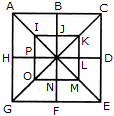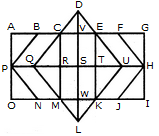REASONING - Online Test
Given that,
- A is the brother of B.
- C is the father of A.
- D is the brother of E.
- E is the daughter of B.
Then, the uncle of D is
Count the number of triangles and squares in the given figure.

The figure may be labelled as shown.

Triangles :
The simplest triangles are IJQ, JKQ, KLQ, LMQ, MNQ, NOQ, OPQ and PIQ i.e. 8 in number. The triangles composed of two components each are ABQ, BCQ, CDQ, DEQ, EFQ, FGQ, GHQ, HAQ, IKQ, KMQ, MOQ and OIQ i.e. 12 in number.
The triangles composed of four components each are ACQ, CEQ, EGQ, GAQ, IKM, KMO, MOI and OIK i.e. 8 in number.
The triangles composed of eight components each are ACE, CEG, EGA and GAC i.e. 4 in number.
Total number of triangles in the figure = 8 + 12 + 8 + 4 = 32.
Squares :
The squares composed of two components each are IJQP, JKLQ, QLMN and PQNO i.e. 4 in number.
The squares composed of four components each are ABQH, BCDQ, QDEF and HQFG i.e. 4 in number.
There is only one square i.e. IKMO composed of eight components.
There is only one square i.e. ACEG composed of sixteen components.
Thus, there are 4 + 4 + 1 + 1= 10 squares in the given figure.
Five people A, B, C, D and E are seated about a round table. Every chair is spaced equidistant from adjacent chairs.
(i) C is seated next to A.
(ii) A is seated two seats from D.
(iii) B is not seated next to A.
Which of the following must be true?
(I) D is seated next to B.
(II) E is seated next to A.
Select the correct answer from the codes given below:
Determine the number of rectangles and hexagons in the given figure.

The figure may be labelled as shown.

Rectangles:
The simplest rectangles are CVSR, VETS, RSWM and STKW i.e. 4 in number.
The rectangles composed of two components each are CETR, VEKW, RTKM and CVWM i.e. 4 in number.
The rectangles composed of three components each are ACRP, PRMO, EGHT and THIK i.e. 4 in number.
The rectangles composed of four components each are CEKM, AVSP,PSWO, VGHS and SHIW i.e. 5 in number.
The rectangles composed of five components each are AETP, PTKO, CGHR and RHIM i.e. 4 in number.
The rectangles composed of six components each are ACMO and EGIK i.e. 2 in number.
The rectangles composed of eight components each are AGHP, PHIO, AVWO and VGIW i.e. 4 in number.
The rectangles composed of ten components each are AEKO and CGIM i.e. 2 in number.
AGIO is the only rectangle having sixteen components.
Total number of rectangles in the given figure
= 4 + 4 + 4 + 5 + 4 + 2 + 4 + 2 + 1 = 30.
Hexagons:
The hexagons in the given figure are CDEKLM, CEUKMQ, CFHJMQ, BEUKNP and BFHJNP.
So, there are 5 hexagons in the given figure.


